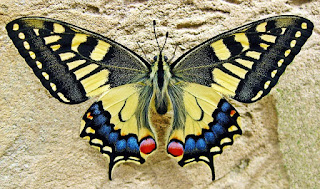Monarch Butterfly Colonies in Portugal and Spain
Monarch (Photo: Public Domain)
I have been wondering what happens to monarch butterflies (Danaus plexippus) that emerge from their chrysalises in the late autumn in Portugal and Spain. I am wondering if there are any organisations or individuals out there that know or are monitoring the colonies and populations of these insects.
Migratory Monarchs
It is common knowledge that these beautiful butterflies conduct an incredible migration from Canada and the northern states of America down to Mexico and California in the south of the US each fall, and then repeat the journey in the opposite direction with the coming of spring.
Overwintering Monarchs (Photo: Public Domain)
The monarchs overwinter in vast numbers that cling to trees. Conservationists have become rightly concerned about the diminishing numbers of monarchs that are arriving to overwinter and that are successfully accomplishing this essential part of their life cycle. Forests in Mexico are being destroyed and freak winter weather due to Climate Change is taking a toll.
In America the subject of monarch migration is being taken very seriously and efforts are being made to monitor the numbers of these butterflies. If you search online for “monitoring of monarch butterflies” you will find plenty of relevant entries for America but not so if you search for “monitoring and distribution of monarch butterflies in Portugal and Spain.” Yes, there are plenty of results but none that I can find that tell you much about the populations in the Iberian countries, only that they exist. It is known that monarchs can be found on the Azores and in Madeira too, as well as the Canary Islands, which count as part of Spain.
Monarchs in Portugal
I have a book I bought in Portugal entitled thebutterfliesofportugal, edited by Ernestino Maravalhas and published by Apollo Books, and it has a distribution map for the monarch butterfly. It is shown as living in the Aveiro area on the northern coast and along the coast of the Algarve in the south.
Monarch caterpillar (Photo: Public Domain)
I have recently obtained some monarch caterpillars from a butterfly farm in Aveiro but the owner tells me there are no monarchs in the north in winter. I have the food-plants scarlet milkweed (Asclepias curassavica) and the bristly fruited silkweed (Gomphocarpus fruticosus) growing here on which the caterpillars are feeding.
Bristly Fruited Silkweed (Photo: Public Domain)
Incidentally it is these plants that have been introduced into Iberia as garden plants that have enabled the monarch to colonise Spain and Portugal. The same goes for Tenerife and the Canary Islands where the scarlet milkweed is often grown as an ornamental garden flower.
Monarch on Milkweed (Photo: Public Domain)
I have successfully reared many monarch butterflies in Tenerife when I lived on the island where there are non-migratory populations, and I know that the insects there continue flying and breeding in the warmer coastal areas through the winter months when it becomes too cold and their food-plants die back in the mountains and higher ground. But I am wondering if the situation is the same in Portugal. If so what temperatures do all stages of the insect need to survive and complete their life-cycle? I estimate my caterpillars are going to need a week more here before they will change into chrysalises and probably a bit longer before they emerge than the ones I have reared before in the slightly warmer part of Tenerife where I lived. I estimate that the butterflies will be emerging late in December but what will they do if I set them free, allowing for sunny and warmer winter days here in Portugal. Will the monarchs attempt to overwinter, will they die doing so or will they fly south?
I have been trying unsuccessfully to find out in searches on the Internet but most information I find is mostly about the migratory monarchs in the US.
I know that the milkweed and bristly-fruited silkweed can continue growing throughout the winter here so the food-plants are available, but I don't know whether it simply gets too cold for any stage of the monarch’s life-cycle to survive. Anyone reading this who can tell me more about the monarchs in Portugal and Spain, please get in touch or leave a comment.
























